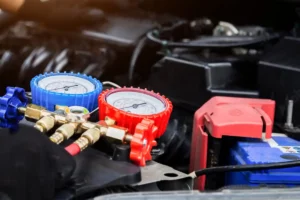It is to introduce 3 common failures and solutions for booster vacuum pump, i.e. motor overload, overheating and backflow.
Roots pump, also known as booster vacuum pump, is frequently used to work together with a primary vacuum pump for many vacuum process equipment. It helps increase the pumping speed and improve the vacuum level. However, you may have following problems during pump operation:
The switch trips during start-up of the Roots pump due to motor overload.
The maximum allowed differential pressure of Roots pumps is generally set at 5000 Pa, and the motor capacity is also set according to this figure.
An example:
Condition: The pumping speed ratio of the Roots pump and the primary pump is 8:1.
Wrong operation: The booster vacuum pump is started at a pressure of 2000 Pa. The differential pressure of the Roots pump is 8 x 2000 Pa – 2000 Pa = 14000 Pa > 5000 Pa.
It exceeds the allowed max differential pressure which causes motor overload and activation of circuit breaker. You need to choose a better primary pump to achieve higher pressure before starting the Roots pump.
As a special advantage, Remarkbl Roots pump is designed to allow high differential pressure from 60 to 180 mbar (6000 – 18000 Pa).
The pump is overheated during operation, which even results in rotors jam.
There’re two reasons for overheating:
1) The air temperature at the inlet is too high. The temperature will rise further after the pumped air passes through the Roots pump. Some unexpected failure may occur if the pump is operated at temperature higher than 80°C for a long time. One possible failure is rotor jam due to its thermal expansion.
To solve this problem, it is recommended to install a heat exchanger ahead of the pump if the air temperature at the inlet exceeds 50°C.
2) The pressure on the exhaust side is too high, especially if the primary pump is a liquid ring vacuum pump. A high differential pressure will lead to overheating, if the sealing liquid of the liquid ring pump is contaminated by the process gas and high vapor pressure is generated.
The liquid from the primary pump flows back to the chamber of the Roots pump.
This often happens in pumping stations of Roots + liquid ring pump. When the liquid ring pump is stopped, the booster vacuum pump is still in vacuum although it’s switched off. The water will flow back from the liquid ring pump into the chamber of the Roots pump. It will even enter the oil tank through the labyrinth seal to emulsify the vacuum oil and damage the bearings.
Therefore, the inlet of the liquid ring pump must be exposed to the atmosphere before stopping the liquid ring vacuum pump and maintain such status for about 30 seconds after pump stopping.
Coolink, a TOP 3 Global HVAC Vacuum Pump Manufacturer & Quality Industrial Vacuum Pump Supplier from China






